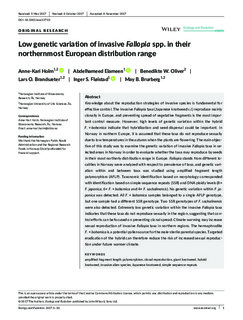| dc.contributor.author | Holm, Anne-Kari | |
| dc.contributor.author | Elameen, Abdelhameed | |
| dc.contributor.author | Oliver, Benedikte Watne | |
| dc.contributor.author | Brandsæter, Lars Olav | |
| dc.contributor.author | Fløistad, Inger | |
| dc.contributor.author | Brurberg, May Bente | |
| dc.date.accessioned | 2018-01-03T10:31:02Z | |
| dc.date.available | 2018-01-03T10:31:02Z | |
| dc.date.created | 2017-12-21T10:40:32Z | |
| dc.date.issued | 2017 | |
| dc.identifier.issn | 2045-7758 | |
| dc.identifier.uri | http://hdl.handle.net/11250/2474305 | |
| dc.description.abstract | Knowledge about the reproduction strategies of invasive species is fundamental for effective control. The invasive Fallopia taxa (Japanese knotweed s.l.) reproduce mainly clonally in Europe, and preventing spread of vegetative fragments is the most important control measure. However, high levels of genetic variation within the hybrid F. × bohemica indicate that hybridization and seed dispersal could be important. In Norway in northern Europe, it is assumed that these taxa do not reproduce sexually due to low temperatures in the autumn when the plants are flowering. The main objective of this study was to examine the genetic variation of invasive Fallopia taxa in selected areas in Norway in order to evaluate whether the taxa may reproduce by seeds in their most northerly distribution range in Europe. Fallopia stands from different localities in Norway were analyzed with respect to prevalence of taxa, and genetic variation within and between taxa was studied using amplified fragment length polymorphism (AFLP). Taxonomic identification based on morphology corresponded with identification based on simple sequence repeats (SSR) and DNA ploidy levels (8× F. japonica, 6× F. × bohemica and 4× F. sachalinensis). No genetic variation within F. japonica was detected. All F. × bohemica samples belonged to a single AFLP genotype, but one sample had a different SSR genotype. Two SSR genotypes of F. sachalinensis were also detected. Extremely low genetic variation within the invasive Fallopia taxa indicates that these taxa do not reproduce sexually in the region, suggesting that control efforts can be focused on preventing clonal spread. Climate warming may increase sexual reproduction of invasive Fallopia taxa in northern regions. The hermaphrodite F. × bohemica is a potential pollen source for the male-sterile parental species. Targeted eradication of the hybrid can therefore reduce the risk of increased sexual reproduction under future warmer climate. | nb_NO |
| dc.language.iso | eng | nb_NO |
| dc.rights | Attribution-NonCommercial-NoDerivatives 4.0 Internasjonal | * |
| dc.rights.uri | http://creativecommons.org/licenses/by-nc-nd/4.0/deed.no | * |
| dc.title | Low genetic variation of invasive Fallopia spp. in their northernmost European distribution range | nb_NO |
| dc.type | Journal article | nb_NO |
| dc.type | Peer reviewed | nb_NO |
| dc.description.version | publishedVersion | nb_NO |
| dc.source.journal | Ecology and Evolution | nb_NO |
| dc.identifier.doi | 10.1002/ece3.3703 | |
| dc.identifier.cristin | 1530837 | |
| cristin.unitcode | 192,10,2,0 | |
| cristin.unitname | Institutt for plantevitenskap | |
| cristin.ispublished | true | |
| cristin.fulltext | original | |
| cristin.qualitycode | 1 | |

